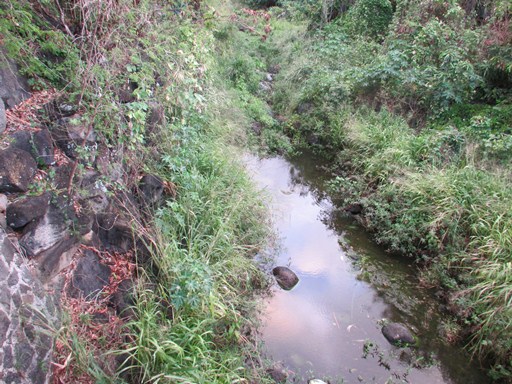
Wailupe Stream at the Ani Street bridge, February 21, 2013. Photo by Andrea Wagner.

The trail we use to hike into Wailupe Valley is reputed to be a remnant of the old mauka-makai trail used by Hawaiians in the valley. Following is some information I have gleaned in my explorations of the valley's history: Wailupe (literally, “kite water”) suggests this was one of the prescribed places to fly kites, some suggesting the land was named “for a kite-flying woman (he wāhine hoʻolele lupe.)”
Another name for the area was Kekaha (“the place”) and is noted in the names of the winds the canoes could expect while sailing along the southeast coast of Oʻahu.
Puuokona is of Kuliʻouʻou Ma-ua is the wind of Niu Holouhā is of Kekaha (Wailupe) Māunuunu is of Wai‘alae The wind of Lēʻahi turns here and there Three gulches form the valley: the main Wailupe Gulch follows the lower Wailupe Stream and a branch to the northwest the northeast branch follows Laulaupoe Gulch, which is named for a round (poe) type of leaf package (laulau) used for food and for presentations. Above is a third gulch called Kuluʻī, which is named for a type of tree/shrub. On early maps, a second small stream is shown on the western side called Waialiʻi (probably “water of the chiefs”)
Ownership of Wailupe is interesting:
Wailupe is part of the tradition of Kamapuaʻa; after Kamapuaʻa conquered Oʻahu, Lonoawohi, his priest, asked for and received the lands whose names begin with the word “wai” (i.e. Waikiki, Waianae, Waiawa … and Wailupe. Thus, the priests of the Lono class received the “wai” lands. The land of Wailupe was reportedly distributed to the father of Kamaha by Kamehameha the Great following the Battle of Nuʻuanu in 1795.
At the Māhele, Kamaha, konohiki (land manager) of the land, received Wailupe, retaining half and returning half. (The King accepted “the large Fish pond (Wailupe Pond) and one acre of Kula land in the Ili of ‘Wailupe’ Oʻahu;” Kamaha received the remainder of the land and all of the smaller fishponds.) In Wailupe, 57 claims were made and 37 were awarded, indicating that there was substantial settlement in the area. The claims were mainly for kula lands with sweet potato, coconut, orange, hala, ipu and pili grass with no mention of taro being grown. Lots averaged 1.5-acres with two kula patches. The majority of lots were adjacent to major streams within the valley 1924, Robert Hind purchased 2,090-acres and established the Hind-Clarke Dairy 1946, Hind sold his dairy operation to Creameries of America, and soon after that began to develop the remainder of his land for residential use; the former cattle pasture was subdivided into lots to form a new residential community called ‘Āina Haina (which means, “Hind’s land”); soon after this the Hawaiian Dredging Company filled in the old Wailupe Fishpond, forming the Wailupe Circle subdivision; a deep channel (depth of approximately 12 to 20 feet) was dredged around the pond, as well as a channel through the reef to the open ocean) and dredge material filled in the pond ‘Āina Haina Shopping Center was built in 1950; Hawaiʻi’s first McDonald's opened there on November 2, 1968; the Hind Clark Dairy operation occupied the area now used as ʻĀina Haina Shopping Center and ʻĀina Haina Elementary School.
As we hike along the trail in upper Wailupe, we pass from privately owned land through government-owned land (mix of city and county and State lands), moving through areas of ferns, bamboo, and up to an area of Cooke pines. There are remainders of stone platforms along the way that may indicate a heiau or house platform. Elepaio frequent the upper valley, where DLNR fenced off an area to attempt to protect the elepaio from rats and other predators.
 Email Richard dot J dot Wagner at gmail dot com
Email Richard dot J dot Wagner at gmail dot com
index.html, this hand crafted HTML file was created February 20, 2013.
Last updated February 28, 2018, by
Rick Wagner. Copyright © 2013-2018, all rights reserved.